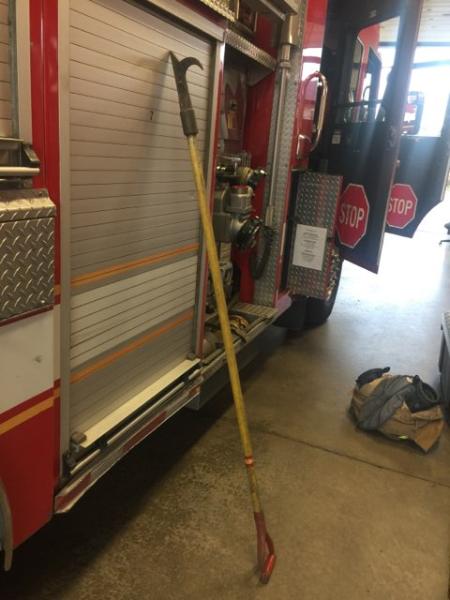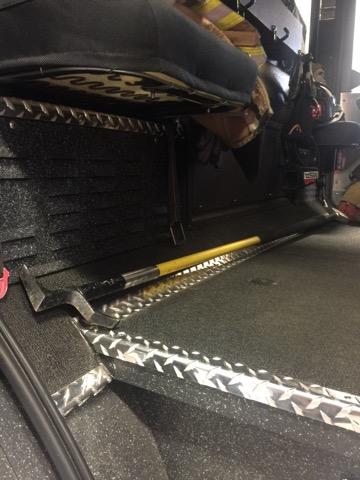Sirens still wailing the engine crew jumps out of the truck the second it stops. Jolted out of bed at the bunkhouse 15mins earlier from a deep sleep the wild topspeed drive to the scene has left the four of them wide awake. As they size up the scene they each begin final gear checks and grab their tools from the truck. One grabs pike poles of various lengths, another a set of “irons” (a famous combo of a Halligan tool, and a fire axe), the others outfit themselves with an assortment of general issue tools and ready the attack line. Approaching the door, fully encumbered by their gear one of them must set down a tool to free a hand and try the lock, luckily this night it is open (though according to my survey results nearly 25% of the times that’s not the case and precious time is spent trying to force entry). Entering the small two story house the firefighter with the pike-pole goes in and begins probing the ceiling, checking for fire extensions. She walks just ahead of the attack line. As she enters the family room the ceiling sweeps upward to the vaulted ceilings that are popular in this neighborhood, the 6’ foot pike pole she carries won’t come close to reaching, and the 8 footer was left on the truck because it’s far too cumbersome to carry unless it is absolutely required. More time must be wasted running back to the truck and attempting to carefully drag the pole through the tight, increasingly smoke-filled hallways trying all the while not to get the hook caught up on doorways and obstacles the entire trip. On her way back from the truck having retrieved the longer pole she passes the terrified family waiting outside, hoping against hope to hear that their dog has been rescued, knowing that as the moments go by so do the chances of a happy outcome.

This was a fictional account, but one based in fact it begins to contextualize the very real environment of the issues, the problematic, that firefighters are currently facing every day. Firefighters, especially engine crews, are overburdened and under equipped with current demolition/hand tools. Engine crews must carry everything they need to attack the fire with them and are often the first on the scene until ladder crews can arrive and assist from outside. In an interview my expert; 23 year veteran of the Columbus Fire Department, Laura Elford described the current situation that engine crews face;
“..you already have a lot of stuff on your back and you can’t see and then sometimes you need your hands to move stuff and if it’s really really dark and you set your tool down you lose it, or you put it by your leg or whatever.” (Laura Elford)
They have so much on their backs and in their hands that performing their critical tasks take longer and are more complicated, putting their safety as well as that of the public at undue risk. Having to set down and possibly lose a critical tool, or simply having to take time or added strain to stop and pick it back up adds undue danger. The extremely vital pike poles that are issued are either too long to be practically brought on scene, or too short to be effective for all but the lowest ceilings. Often crews must go back and forth from the truck, through the fireground, to retrieve a tool that had been left behind due to its weight or awkwardness. The extra time wasted spent dealing with the challenges presented by poor equipment in the above fictional account happens with far too much regularity in the real world, and when seconds can equal lives, this is simply unacceptable.
The geographical area in which the fire department operates plays a huge role in the types of challenges they will face. For example urban environments in areas of high crime tend to be more heavily secured which complicates forcible entry. Also areas with older buildings that predate ADA compliance and stricter building codes are even more difficult to get through when carrying bulky gear and equipment. No two areas are the same and far too often the purchasing decisions made in selecting the equipment issued to these firefighters has ignored this simple truth. The result has been an expressed need to create or acquire tools that are better suited to the unique areas and users that need them. Laura explained to me that, unsatisfied by the tools available to them, members of the department spent their own time and money to create tools that would work better for them.
“The other guys started making up their own tools using their imaginations, but for me I just make do with what we have and make it work.”(Laura Elford)
The reason for the desire to adapt or create better tools is clear when the enormity of many of the tasks faced by these individuals is even partially appreciated. Try to imagine having to drag several hooked poles (some over 8 feet in length) by hand through an unknown space with limited visibility in the chaos of a fire, while wearing 75lbs of gear and gloves which reduce your dexterity even further. Or if you aren’t tasked with carrying the poles, you’re instead burdened with the “irons”, one in each hand; a Halligan and an axe weighing 12 and 9 lbs respectively. Every time you go to move something you must set one or both down.
When issuing this generic gear, departments also tend to forget or ignore the fact that firefighters are individuals, just like every group of individuals there is no “one size fits all” as firefighters come in all shapes, sizes, and genders. Physiological differences between firefighters are completely unaddressed with the standard issue equipment of most departments and this causes further complications, inefficiency, and injury many of these decisions are due to the complexities of the budgeting and legal systems in place which inherently favor generic one size fits all equipment. It is no coincidence that the according to the NFPA the number one cause of injury to firefighter on scene is strain/sprain. This makes sense considering the loads they’re carrying. In Laura’s case the fact that she is below average height and smaller than most causes extra challenges and a sense that these tools weren’t made for her. She often blames herself for what is in truth poor design, and poor department level tool choice.
“I’m on the engine company and we usually have the hose so a lot of time if were looking for the fire we need to get in the walls and look for extensions so we need something little, and most of our pike poles are so long that it gets in the way, snagged, caught on doors.” It might just be me being short and everything, maybe I’m just not carrying it the right way or whatever.” (Laura Elford)

In making budget decisions and equipment choices, departments should be made aware of the needs and special requirements of their firefighters, and the unique challenges presented by the area in which they operate. In addition to this raised awareness, departments and individual firefighters must be empowered by access to tools that better address these needs and which work better for everyone regardless of size.
Given that efficiency in accomplishing firefighting tasks is often directly correlated to lives and property saved, and that much of this efficiency depends on the use of individually carried hand tools, and that many of these tools are currently too heavy, cumbersome, and inefficient; how might we offer firefighters a more portable, efficient, and highly versatile demolition tool that affords hands-free carry?

![DTSNorwoodPark2Fire-600x400[1]](https://desis.osu.edu/seniorthesis/wp-content/uploads/2019/09/DTSNorwoodPark2Fire-600x4001.jpg)


